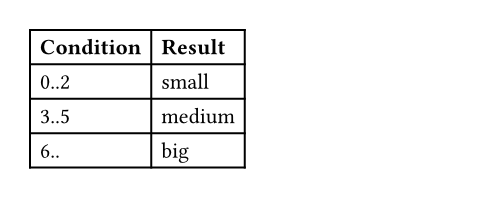csv
Reads structured data from a CSV file.
The CSV file will be read and parsed into a 2-dimensional array of strings: Each row in the CSV file will be represented as an array of strings, and all rows will be collected into a single array. Header rows will not be stripped.
Example
#let results = csv("example.csv")
#table(
columns: 2,
[*Condition*], [*Result*],
..results.flatten(),
)

Parameters
source
A path to a CSV file or raw CSV bytes.
delimiter
The delimiter that separates columns in the CSV file. Must be a single ASCII character.
Default: ","
row-type
How to represent the file's rows.
- If set to
array, each row is represented as a plain array of strings. - If set to
dictionary, each row is represented as a dictionary mapping from header keys to strings. This option only makes sense when a header row is present in the CSV file.
Default: array
Definitions
decodecsv.decode is deprecated, directly pass bytes to csv instead; it will be removed in Typst 0.15.0
Reads structured data from a CSV string/bytes.
data
CSV data.
delimiter
The delimiter that separates columns in the CSV file. Must be a single ASCII character.
Default: ","
row-type
How to represent the file's rows.
- If set to
array, each row is represented as a plain array of strings. - If set to
dictionary, each row is represented as a dictionary mapping from header keys to strings. This option only makes sense when a header row is present in the CSV file.
Default: array